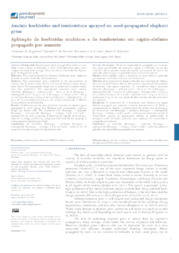Auxinic herbicides and tembotrione sprayed on seed-propagated elephant grass.
Auxinic herbicides and tembotrione sprayed on seed-propagated elephant grass.
Author(s): BRIGHENTI, A. M.; OLIVEIRA, M. F. de; LEDO, F. J. da S.; MACHADO, J. C.
Summary: ABSTRACT - Background: Elephant grass plants propagated by seeds are more likely to have injuries to herbicides, in their initial cultivation phase, when compared to those from cuttings. There are selective herbicides for elephant grass developed from seeds. Objective: This work evaluated the tolerance of elephant grass implanted by seeds to auxinic herbicides and tembotrione. Methods: Two experiments were conducted in the municipalities of Valença, Rio de Janeiro State, Brazil, and Coronel Pacheco, Minas Gerais State, Brazil. The experimental design was in randomized complete blocks, with four replications. The experimental treatments were: Auxinic herbicides {fluroxypyr + picloram [160 + 160 g a.e. ha-1]; fluroxypyr + aminopyralid [160 + 80 g a.e. ha-1]; fluroxypyr + triclopyr [160 + 480 g a.e. ha-1]; 2,4-D amine (1,340 g a.e. ha-1); 2,4-D amine + picloram [720 + 45 g a.e. ha-1]}, and tembotrione (84 g a.i. ha-1 without mineral oil), in addition to the control without herbicides. Results: Tembotrione was the most phytotoxic treatment to elephant grass propagated by seed, causing leaf bleaching and, consequently, reducing forage dry matter yield. The treatments with fluroxypyr + picloram, fluroxypyr + aminopyralid, fluroxypyr + triclopyr, 2,4-D and 2,4-D + picloram did not cause symptoms of phytotoxicity capable of providing a reduction in forage productivity, being potential herbicides for spraying in seed-propagated elephant grass fields. Conclusions: the herbicides: fluroxypyr + picloram, fluroxypyr + aminopyralid, fluroxypyr + triclopyr, 2,4-D and 2,4-D + picloram can be sprayed in the elephant grass developed from seeds. RESUMO - Introdução: Plantas de capim-elefante propagadas por sementes têm maior possibilidade em apresentar injúrias a herbicidas, na sua fase inicial de cultivo, quando comparadas àquelas provenientes de estacas. Há herbicidas seletivos para o capim-elefante proveniente de sementes. Objetivo: Este trabalho avaliou a tolerância do capim-elefante implantado por sementes a herbicidas auxínicos e ao tembotrione. Métodos: Dois experimentos foram conduzidos nos municípios de Valença, RJ, e em Coronel Pacheco, MG. O delineamento experimental foi em blocos casualizados, com quatro repetições. Os tratamentos foram: herbicidas auxínicos {fluroxypyr + picloram [160 + 160 g e.a. ha-1]; fluroxypyr + aminopyralid [160 + 80 g e.a. ha-1]; fluroxypyr + triclopyr [160 + 480 g e.a. ha-1); 2,4-D (1.340 g e.a. ha-1); 2,4-D + picloram [720 + 45 g e.a. ha-1]} e o tembotrione (84 g i.a. ha-1 sem adição de óleo mineral), além da testemunha se aplicação. Resultados: O tembotrione foi o tratamento mais fitotóxico ao capimelefante propagado por sementes, causando branqueamento de folhas e, consequentemente, redução na produtividade de matéria seca de forragem. Os tratamentos com fluroxypyr + picloram, fluroxypyr + aminopyralid, fluroxypyr + triclopyr, 2,4-D e 2,4-D + picloram não causaram sintomas de fitotoxicidade capazes de proporcionar redução na produtividade de forragem, sendo herbicidas potenciais para aplicação em capim-elefante propagado por sementes. Conclusões: os herbicidas fluroxypyr + picloram, fluroxypyr + aminopyralid, fluroxypyr + triclopyr, 2,4-D e 2,4-D + picloram podem ser aplicados em capim-elefante propagado por sementes.
Publication year: 2022
Types of publication: Journal article
Unit: Embrapa Dairy Cattle
Keywords: Auxina, Auxins, Branqueamento, Capim Elefante, Erva Daninha, Herbicida, Planta daninha, Synthetic auxins, Tembotrione, Weeds
Observation
Some of Embrapa's publications are published as ePub files. To read them, use or download one of the following free software options to your computer or mobile device. Android: Google Play Books; IOS: iBooks; Windows and Linux: Calibre.
Access other publications
Access the Agricultural Research Database (BDPA) to consult Embrapa's full library collection and records.
Visit Embrapa Bookstore to purchase books and other publications sold by Embrapa.

